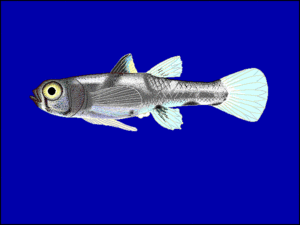Dwarf pygmy goby facts for kids
Quick facts for kids Dwarf pygmy goby |
|
|---|---|
 |
|
| Conservation status | |
| Scientific classification |
The dwarf pygmy goby or Philippine goby (Pandaka pygmaea) is a tiny fish found in warm waters. It lives in places where fresh water mixes with salt water, like mangrove areas in Southeast Asia. This amazing fish is one of the smallest fish species on Earth! Male gobies grow to about 0.9 to 1.1 centimeters (0.35 to 0.43 inches) long. Females can be a bit bigger, reaching up to 1.5 centimeters (0.59 inches) in total length. An adult dwarf pygmy goby weighs around 0.00015 ounces (4.25 milligrams). In the Philippines, people call this fish bia or tabios.
Contents
Where Does This Tiny Fish Live?
The dwarf pygmy goby was first found in Malabon, Metro Manila in the Philippines. It lived along shady river banks there. Sadly, this area was changed into land, and the fish can no longer be found there. Because of this, the fish is now considered very close to disappearing by the IUCN.
But don't worry! More recently, dwarf pygmy gobies have been found in other places across Southeast Asia. These include Culion Island in the Philippines, Bali and Sulawesi in Indonesia, and Singapore. In 1958, some of these fish were even brought to Germany for aquariums.
This little fish prefers shallow, warm water that is a mix of fresh and salt water. It often lives in mangrove areas. You can usually find it on muddy bottoms or hiding among plants. The dwarf pygmy goby was even known as the National Fish in the Philippines in 1994, until the milkfish took its place.
What Does the Dwarf Pygmy Goby Look Like?
The dwarf pygmy goby is almost see-through and has no color. Its body is somewhat long and strong. Male gobies are thin with straight top and bottom outlines. Females are a bit wider, with a slightly curved back and a round belly.
This fish has a large, blunt head. Its head and the back of its neck are smooth, without scales. The head is wider than it is deep. It has a very short, wide, and rounded snout. The mouth points upwards, and its lower jaw sticks out. The mouth reaches back to the middle of the eye.
The dwarf pygmy goby has two rows of teeth in each jaw. The outer teeth in the upper jaw are bigger and spaced further apart. The inner teeth are very tiny. This fish has two dorsal fins (fins on its back). The first one is low and sits in front of the second fin. Its pectoral fins (side fins) and ventral fins (belly fins) are pointed. The ventral fins are about the same length as, or longer than, the pectoral fins.
The dwarf pygmy goby has dark spots on its sides, which form four bands across its body. The bases of its fins are dark, except for the belly fins. It has 22 to 25 scales in a line along its body.
Behavior of the Goby
What Does It Eat?
This tiny fish eats very small living things that float in the water, called plankton.
Reproduction and Life Cycle
The dwarf pygmy goby is an oviparous species. This means that the female fish lays eggs.
Fun Facts About the Dwarf Pygmy Goby
The Pandaka pygmaea was once shown on a Philippine ten centavo coin. What's cool is that on the coin, the fish was shown at its actual size! The name of its group, Pandaka, comes from the Filipino word pandak. This word means "dwarf" or "short".
See also
- Seven-figure pygmy goby



